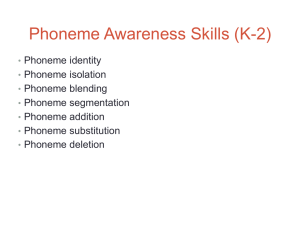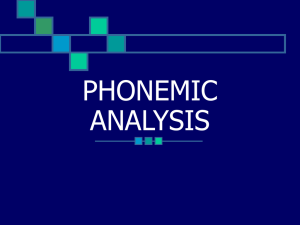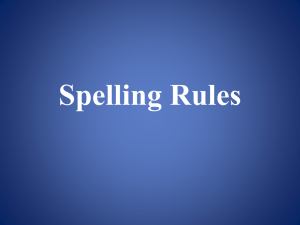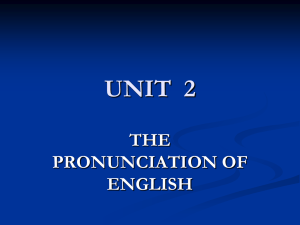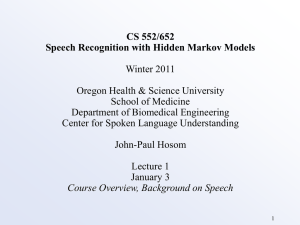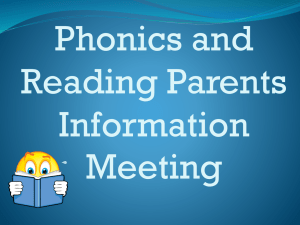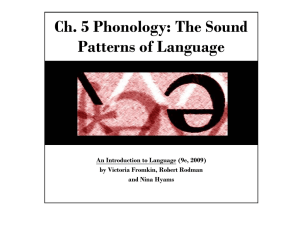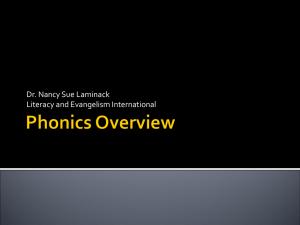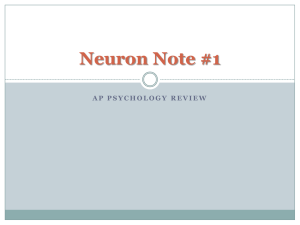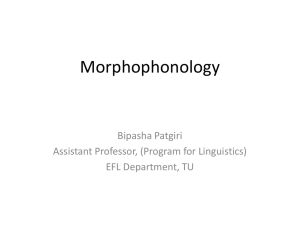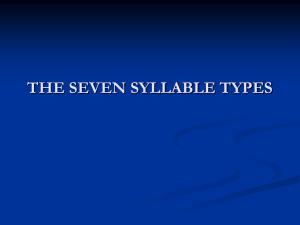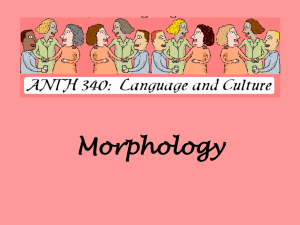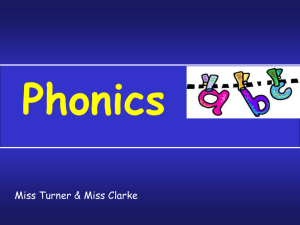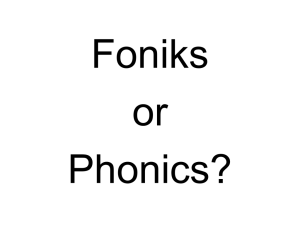D Grime-Chapter 1 PP Presentation
advertisement
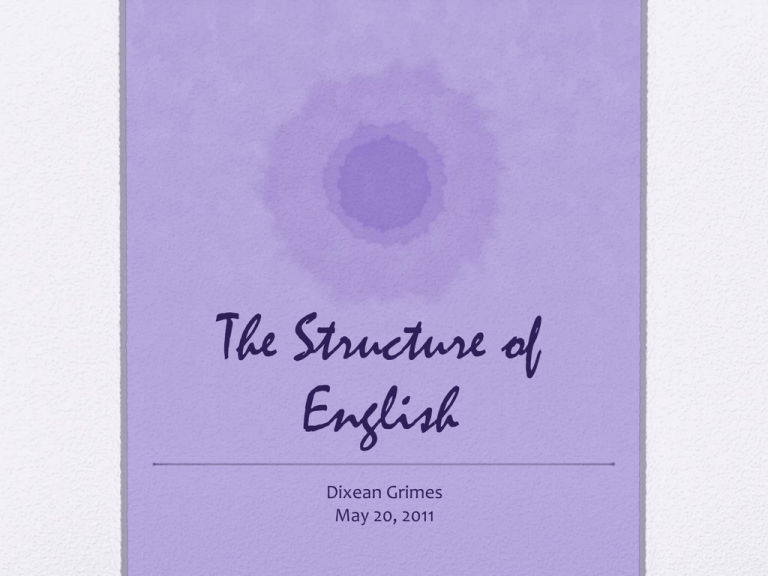
The Structure of English Dixean Grimes May 20, 2011 WHAT? Phonemes • A phoneme is the smallest unit of spoken language that makes a difference in a word’s meaning. • The Greek meaning of (phon) is: sound, and (eme) is: a little piece of something. • 42-44 different sounds, or phonemes. • The number varies according to dialect, individual speech patterns, changes in stress, and other variables. • Refer to chart on page 23. WHAT? Consonant Phonemes • 18 consonant phonemes such as /d/ and /t/ are represented by a single letter. • 7 phonemes, such as /ch/ and /sh/ are represented by two letters. • The letters c, q, and x do not have a unique phoneme assigned to them. • Refer to charts on pages 24 and 25. WHAT? Vowel Phonemes • The vowel letters a, e, I, o, and u are used singly and in combination to represent the different sounds. • Including r- controlled vowels, there are 18 vowel phonemes, or sounds. WHAT? Consonant Phoneme Classifications • Consonants may be classified according to place of articulation. (Where in the mouth is the sound produced?) • Manner of articulation. (How is the sound produced?) • Voiced ( Vocal chords vibrate) or unvoiced (Vocal chords do not vibrate). • To produce a consonant sound, vocal airflow is either partially or completely obstructed as it moves through the mouth. • All consonants are not equally accessible in spoken language. WHAT? Vowel Phoneme Classifications • Vowels are a class of open, unobstructed speech sounds that are not consonants. <Moats, 2000> • American English has 15 vowel phonemes. • At least three r-controlled vowel combinations that are often classified as vowels. • Vowels can be classified according to: − − − − Place of articulation Tongue position (front to back, high to low) Lip position (wide and smiling, rounded and wide open. rounded and partially open) Pronunciation of a vowel may vary according to regional and dialect differences. • A diphthong sound shifts in the middle as the lips change position from the rounded to smile. • Refer to chart on page 27. WHAT? Sound Spellings A PHONEME/GRAPHEME PAIRING • A letter is a grapheme, or written representation of one sound. • Phonics instruction: Teaching the relationship between sounds (phonemes) and the spellings (graphemes) used to represent them. • These two together are sound spellings, or phoneme/grapheme pairings. WHAT? Sound Spellings PHONIC ELEMENTS • In the English language, phonic elements can be used to categorize the common sound/spellings, which are used to form words. • After the single letter phonic elements (consonants and short vowels) • It is the multiple spelling representations for the SAME SOUNDS that students find challenging. • Refer to charts on pages 29 through 34. WHAT? Sound Spellings Most Frequent English Sound/Spellings • It is useful to know which sound/spellings are important to teach and which can be learned on an as-needed basis. • The following chart shows the most frequent spellings of the 43 phoneme sounds covered in this book. • The percentages provided in parentheses are based on the number of occurrences in which each sound/spelling appeared in the 17,000 most frequently used single and multisyllabic words. • Refer to chart on page 35. WHAT? Syllables • A syllable is a word or part of a word pronounced as a unit. • Each syllable contains only one vowel sound. • There are six common types of syllables and four useful principles of syllable division. • Refer to charts on pages 36 and 37. WHAT? Onset-Rime The two parts of a syllable: Onset and Rime • The onset is the part of a syllable that comes before the vowel. It may be a consonant, consonant blend, or digraph. • The rime is the vowel and everything after it. • Sing, thing, bring: − Rime= ing − Onset= s, th, br • All syllables do not have an onset; for example, I, it, and out. • Refer to the chart on page 38. WHAT? Onset-Rime Phonograms • A nonlinguistic term for rime. • In the word back, -ack is the phonogram; it is also the rime. • A small number of phonograms can be used to generate a large number of words. • 500 primary-grade words can be derived from only 37 “rhyming” phonograms. • Refer to the charts on pages 38 though 39. WHAT? Morphemes Word–Part Clues • The meaningful parts of words • Root words • Prefixes • Suffixes • Greek and Latin roots WHAT? Morphemes The majority of morphemes come from three languages: Greek, Latin, and Anglo-Saxon. • May be one syllable (pig) or more than one syllable(elephant). • May be a whole word or part of a word. • Two types: Free and bound. • Free: Can stand alone as words. • Bound: Must be attached to other morphemes to make words. WHAT? Morphemes Anglo Saxon Root Words • Root words are free morphemes. • A root word is a single word that cannot be broken into smaller words or parts. • Anglo-Saxon root words are words from which many other words are formed. WHAT? Morphemes Compound Words • Compound words are composed of two root words. • The meaning of some compound words can be derived from the meanings of the two smaller words that comprise them (doghouse, bluebird). • Other compound words have a meaning that differs from the meaning of the two smaller words (butterfly, airline). • Refer to chart on page 43. WHAT? Morphemes Derivational Suffixes • Word parts that are “fixed” to the end of root words. • Usually alter the meaning of the root word to which they are attached. • May change the root word’s part of speech, pronunciation, or spelling. WHAT? Morphemes Inflectional Suffixes • Word parts that are “fixed” to the end of root words. • Change the form of the root word but not it’s part of speech. • If the root word is a noun: Suffix shows possession. (hers) • If the root word is a verb: Shows tense (walked) − Active or passive voice (it was driven) − State (she had been singing) • If the root word is an adjective, the suffix may show comparison: (louder, loudest) WHAT? Morphemes Greek and Latin Roots • Greek and Latin roots are also bound morphemes. • Most Greek roots appear in combination with each other. • Most Latin roots appear in combination with one or more affixes. • Refer to charts on pages 44 through 47.
